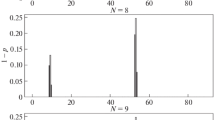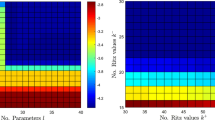Abstract
The longitudinal vibrations of a rod weakened by transverse cracks are considered. Cracks are assumed to be open and modeled by translational springs. The stiffness of the springs corresponds to the size of the cracks. A method has been developed for identifying the number and position of transverse cracks, as well as the stiffness of the corresponding springs according to two spectra that correspond to two types of conditions at the ends of the rod: free—free and fixed—free. The developed method is based on minimizing the objective function that characterizes the difference between the given (measured) natural frequencies and natural frequencies calculated during the implementation of the algorithm. The objective function is minimized using the Levenberg—Marquardt algorithm. Numerical examples are considered. The stability of the obtained results with respect to noise in the initial data is investigated.
Similar content being viewed by others
References
A. D. Dimarogonas, “Vibration of Cracked Structures: a State of the Art Review,” Engng Fract. Mech. 55, 831–857 (1996).
Y. Narkis, “Identification of Crack Location in Vibrating Simply Supported Beams,” J. Sound Vib. 172 (4), 549–558 (1994).
A. Morassi, “A Uniqueness Result on Crack Location in Vibrating Rods,” Inverse Prob. Engng 4, 231–254 (1997).
G. Biscontin, A. Morassi, and P. Wendel, “Asymptotic Separation of the Spectrum in Notched Rods,” J. Vibr. Cont. 4, 237–251 (1998).
A. Morassi, “Identification of a Crack in a Rod Based on Changes in a Pair of Natural Frequencies,” J. Sound Vibr. 242, 577–596 (2001).
R. Ruotolo and C. Surace, “Natural Frequencies of a Bar with Multiple Cracks,” J. Sound Vibr. 272, 301–316 (2004).
M. Dilena and A. Morassi, “The Use of Antiresonances for Crack Detection in Beams,” J. Sound Vibr. 276, 195–214 (2004).
K. V. Singh, “Transcendental Inverse Eigenvalue Problems in Damage Parameter Estimation,” Mech. Syst. Sign. Proc. 23, 1870–1883 (2009).
A. M. Akhtyamov and M. A. Il’gamov, “Flexural Model for a Notched Beam: Direct and Inverse Problems,” Prikl. Mat. Teor. Phiz. 54(1), 152–162 (2013)
A. M. Akhtyamov and M. A. Il’gamov, [J. Appl. Mech. Tech. Phys. (Engl. Transl.) 54(1), 132–141 (2013)].
L. D. Akulenko and S. V. Nesterov, “Mass Defect Influence on the Longitudinal Vibration Frequencies and Mode Shapes of a Beam,” Izv. Ros. Akad. Nauk. Mekh. Tv. Tela, No. 1, 135–144. (2014)
L. D. Akulenko and S. V. Nesterov, [Mech. Sol. (Engl. Transl.) 49 (1), 104–111 (2014)].
M. A. Il’gamov, “Longitudinal Vibrations of a Bar with Incipient Transverse Cracks,” Izv. Ros. Akad. Nauk. Mekh. Tv. Tela, No. 1, 23–31 (2017)
M. A. Il’gamov, [Mech. Sol. (Engl. Transl.) 52 (1), 18–24 (2017)].
L. D. Akulenko, V. G. Baidulov, D. V. Georgievskii, and S. V. Nesterov, “Evolution of Natural Frequencies of Longitudinal Vibrations of a Bar as Its Cross-Section Defect Increases,” Izv. Ros. Akad. Nauk. Mekh. Tv. Tela, No. 6, 136–144 (2017)
L. D. Akulenko, V. G. Baidulov, D. V. Georgievskii, and S. V. Nesterov, [Mech. Sol. (Engl. Transl.) 52(6), 708–714 (2017)].
A. Morassi and M. Rollo, “Identification of Two Cracks in a Simply Supported Beam from Minimal Frequency Measurements,” J. Vibr. Contr. 7, 729–739 (2001).
L. Rubio, J. Fernandez-Saez, and A. Morassi, “Identification of Two Cracks in a Rod by Minimal Resonant and Antiresonant Frequency Data,” Mech. Syst. Sign. Proc. 60–61, 1–13 (2015).
L. Rubio, J. Fernandez-Saez, and A. Morassi, “Identification of Two Cracks with Different Severity in Beams and Rods from Minimal Frequency Data,” J. Vibr. Cont. 22 (13), 3102–3117 (2016).
N. T. Khiem and L. K. Toan, “A Novel Method for Crack Detection in Beam-Like Structures by Measurements of Natural Frequencies,” J. Sound Vibr. 333, 4084–4103 (2014).
E. I. Shifrin, “Identification of a Finite Number of Small Cracks in a Rod Using Natural Frequencies,” Mech. Sys. Sign. Proc. 70–71, 613–624 (2016).
K. V. Singh, “Transcendental Inverse Eigenvalue Problems in Damage Parameter Estimation,” Mech. Sys. Sign. Proc. 23, 1870–1883 (2009).
J. Lee, “Identification of Multiple Cracks in a Beam Using Natural Frequencies,” J. Sound Vibr. 320, 482–490 (2009).
J. Lee, “Identification of a Crack in a Beam by the Boundary Element Method,” J. Mech. Sci. Techn. 24 (3), 801–804 (2010).
S. Casciati, “Stiffness Identification and Damage Localization Via Differential Evolution Algorithms,” Struct. Cont. Health Mon. 15, 436–449 (2008).
N. Khaji and M. Mehrjoo, “Crack Detection in a Beam with an Arbitrary Number of Transverse Cracks Using Genetic Algorithms,” J. Mech. Sci. Techn. 28(3), 823–836 (2014).
U. Eroglu and E. Tufekci, “Exact Solution Based Finite Element Formulation of Cracked Beams for Crack Detection,” Int. J. Sol. Struct. 96, 240–253 (2016).
S. Sandesh and K. Shankar, “Application of a Hybrid of Particle Swarm and Genetic Algorithm for Structural Damage Detection,” Inv. Prob. Sci. Engng. 18 (7), 997–1021 (2010).
L. Rubio, J. Fernandez-Saez, and A. Morassi, “The Full Nonlinear Crack Detection Problem in Uniform Vibrating Rods,” J. Sound Vibr. 339, 99–111 (2015).
J. Fernandez-Saez, A. Morassi, M. Pressacco, and L. Rubio, “Unique Determination of a Single Crack in a Uniform Simply Supported Beam in Bending Vibration,” J. Sound Vibr. 371, 94–109 (2016).
E. I. Shifrin, “Inverse Spectral Problem for a Rod with Multiple Cracks,” Mech. Syst. Sig. Proc. 56–57, 181–196 (2015).
E. I. Shifrin, “Inverse Spectral Problem for a Non-Uniform Rod with Multiple Cracks,” Mech. Syst. Sign. Proc. 96, 348–365 (2017).
J. M. Melenk and I. Babuska, “The Partition of Unity Finite Element Method: Basic Theory and Applications,” Comp. Met. Appl. Mech. Engng 139, 289–314 (1996).
I. Babuska and J. M. Melenk, “The Partition of Unity Method,” Int. J. Num. Met. Engng 40, 727–758 (1997)
M. Arndt, R. D. Machado, and A. Scremin, “An Adaptive Generalized Finite Element Method aapplied to Free Vibration Analysis of Straight Bars and Trusses,” J. Sound Vibr. 329, 659–672 (2010).
K. Levenberg, “A Method for the Solution of Certain Non-Linear Problems in Least Squares,” Quart. Appl. Math. 2 (2), 164–168 (1944).
D. W. Marquardt, “An Algorithm for the Least-Squares Estimation of Nonlinear Parameters,” SIAM J. Appl. Math. 11 (2), 431–441 (1963).
M. Lampton, “Damping-Undamping Strategies for Levenberg-Marquardt Nonlinear Least-Squares Method,” Comp. Phys. 11 (1), 110–115 (1997).
M. I. A. Lourakis, “A Brief Description of the Levenberg-Marquardt Algorithm Implemented by Levmar,” Found. Res. Techn. 4 (1), 1–6 (2005).
J. Pujol, “The Solution of Nonlinear Inverse Problems and the Levenberg-Marquardt Method,” Geophys. 72(4), W1–W16 (2007).
F. Sarvi, S. Shojaee, and P. Torkzadeh, “Damage Identification of Trusses by Finite Element Model Updating Using an Enhanced Levenberg-Marquardt Algorithm,” Int. J. Opt. Civil Engng. 4 (2), 207–231 (2014).
R. L. Fox and M. P. Kapoor, “Rates of Change Eigenvalues and Eigenvectors,” AIAA J. 6 (12), 2426–2429 (1968).
R. B. Nelson, “Simplified Calculation of Eigenvector Derivatives,” AIAA J. 14 (9), 1201–1205 (1976).
N. P. Van Der Aa, H. G. Ter Morsche, and R. R. M. Mattheij, “Computation of eigenvalue and eigenvector derivatives for a general complex-valued eigensystem,” Electron. J. Lin. Alg. 16(1), 300–314 (2007).
E. I. Shifrin and R. Ruotolo, “Natural Frequencies of a beam with an Arbitrary Number of Cracks,” J. Sound Vibr. 222 (3), 409–423 (1999).
Author information
Authors and Affiliations
Corresponding author
Additional information
Russian Text © The Author(s), 2019, published in Izvestiya Akademii Nauk, Mekhanika Tverdogo Tela, 2019, No. 4, pp. 8–26.
Acknowledgement
This work was carried out on the subject of state assignment No. of state registration AAAA-A17-117021310386-3 and with the support of the RFBR (project No. 19-01-00100).
About this article
Cite this article
Lebedev, I.M., Shifrin, E.I. Solution of the Inverse Spectral Problem for a Rod Weakened by Transverse Cracks by the Levenberg—Marquardt Optimization Algorithm. Mech. Solids 54, 857–872 (2019). https://doi.org/10.3103/S0025654419060025
Received:
Revised:
Accepted:
Published:
Issue Date:
DOI: https://doi.org/10.3103/S0025654419060025




